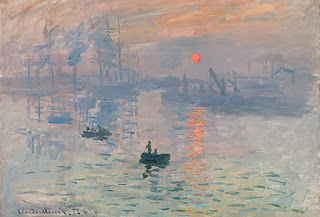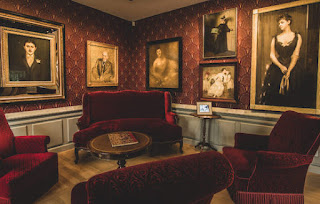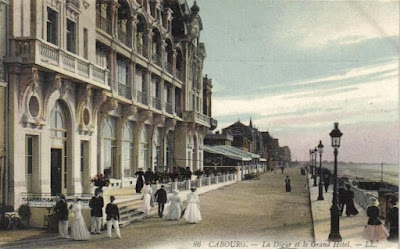 |
| Honfleur, Vieux Bassin ©SMA76T.LeMassonBanningLover |
By Jacquelin Carnegie
HONFLEUR: SOAK IN THE BEAUTY
“A ravishing port full of masts and sails, crowned with green hills and surrounded by narrow houses”--this is how the famous author Victor Hugo described Honfleur in the 19th century--and it’s still so today.
Honfleur is another truly-lovely town on Normandy’s “Côte Fleurie” (Flowery Coast) that has been a favorite of artists for centuries. Spend some time in the heart of town admiring the Vieux Bassin (old harbor), lined with 16th- to 18th-century houses, and you’ll understand why.
Have a plateau de fruits de mer (seafood platter) at one of the charming cafés. Try some local, apple-brandy Calvados and delicious Normandy cheeses. Then, stroll along the winding, cobblestone streets stopping into quaint shops and art galleries. But, be sure to visit these sites:
An Inspiration To Artists
Honfleur is another truly-lovely town on Normandy’s “Côte Fleurie” (Flowery Coast) that has been a favorite of artists for centuries. Spend some time in the heart of town admiring the Vieux Bassin (old harbor), lined with 16th- to 18th-century houses, and you’ll understand why.
Have a plateau de fruits de mer (seafood platter) at one of the charming cafés. Try some local, apple-brandy Calvados and delicious Normandy cheeses. Then, stroll along the winding, cobblestone streets stopping into quaint shops and art galleries. But, be sure to visit these sites:
An Inspiration To Artists
 |
| Claude Monet, Impression, Sunrise (1872) Musée Marmottan |
It’s thought, among many art historians, that Impressionism originated here. The artist Eugène Boudin, born in Honfleur, was Claude Monet’s mentor, introducing him to en plein air (in the open air) painting--working outdoors rather than in a studio. In 1858, when Monet was just 18 years old, Boudin coaxed him to paint the nature around them--clouds, sun, the seashore--and the way objects changed according to the fluctuating daylight. Boudin’s plein-air style was also an inspiration to many future generations of artists who flocked to Honfleur from Georges Seurat, the founder of Neo-Impressionism (Pointillism), in 1886 to Raoul Dufy in 1928, who credits Honfleur as the place he found his own, true painting style.
Musée Eugène Boudin
Place Erik Satie; https://tinyurl.com/54bry8bk
Musée Eugène Boudin
Place Erik Satie; https://tinyurl.com/54bry8bk
 |
| Eugène Boudin, Summer at Trouville (1890-94) Musée Malraux Le Havre |
Honfleur, the inspiration for Impressionist and pre-Impressionist masters such as JMW Turner, Jean-Baptiste-Camille Corot, Gustave Courbet, Édouard Villard, Johan Jongkind, and Claude Monet, was also the birthplace of Eugène Boudin.
This lovely museum houses a splendid selection of Boudin’s artwork along with a collection of paintings of Honfleur and the Normandy coast done by other prominent, 19th- and 20th-century artists. There are also displays of vintage photographs, tourism posters, antiques, and changing, temporary exhibits.
Maisons Satie
67 Blvd Charles V; https://tinyurl.com/p73p9y8r
This lovely museum houses a splendid selection of Boudin’s artwork along with a collection of paintings of Honfleur and the Normandy coast done by other prominent, 19th- and 20th-century artists. There are also displays of vintage photographs, tourism posters, antiques, and changing, temporary exhibits.
Maisons Satie
67 Blvd Charles V; https://tinyurl.com/p73p9y8r
 |
| Maisons Satie ©Florian Vimont |
Honfleur is also the birthplace of Erik Satie, an acclaimed, early 20th-century, avant-garde composer and musician. Satie worked with composers Debussy, Ravel, and Stravinsky as well as with artists and writers such as Picasso, Braque, Cocteau, and filmmaker René Clair. The museum provides a whimsical, surreal way to experience his art and music collaborations.
Église Sainte-Catherine
Place Sainte-Catherine
Église Sainte-Catherine
Place Sainte-Catherine
 |
| ©OTC Honfleur |
St. Catherine's is such a unique church. Constructed by shipbuilders in the 15th century, it’s made entirely of wood. The interior resembles the hull of a ship with many decorative, nautical details. It’s thought to be the largest, wooden church in France.
Stay: There’s everything from B&Bs to luxury hotels.
Cruises: The Seine River meets the sea at Honfleur, so it’s a port-of-call for both riverboats and small, ocean liners. If you enjoy cruising, it’s one way to get here. However, as beautiful as Honfleur is, on the days the cruises arrive, the town is often overrun with tour groups. If you find this a bother, check cruise dates with the Honfleur Tourism office, so you don’t arrive when they do.
CABOURG: THE BELLE ÉPOQUE COMES TO LIFEFamed author Marcel Proust vacationed in Trouville in his younger days. But, when his pals in Paris’ social circles moved on to Cabourg, another magnificent seaside resort on the Calvados coast, so did he.
During the Belle Époque, Proust summered in Cabourg from 1907 to 1914, drawing inspiration for his literary masterpiece, the seven-volume, À la Recherche du Temps Perdu (In Search of Lost Time).
La Villa du Temps Retrouvé
15 Ave du Président Raymond Poincaré; villadutempsretrouve.com
(Open: March-Nov; Guided tours are offered in French & English)
Cruises: The Seine River meets the sea at Honfleur, so it’s a port-of-call for both riverboats and small, ocean liners. If you enjoy cruising, it’s one way to get here. However, as beautiful as Honfleur is, on the days the cruises arrive, the town is often overrun with tour groups. If you find this a bother, check cruise dates with the Honfleur Tourism office, so you don’t arrive when they do.
***
CABOURG: THE BELLE ÉPOQUE COMES TO LIFEFamed author Marcel Proust vacationed in Trouville in his younger days. But, when his pals in Paris’ social circles moved on to Cabourg, another magnificent seaside resort on the Calvados coast, so did he.
During the Belle Époque, Proust summered in Cabourg from 1907 to 1914, drawing inspiration for his literary masterpiece, the seven-volume, À la Recherche du Temps Perdu (In Search of Lost Time).
La Villa du Temps Retrouvé
15 Ave du Président Raymond Poincaré; villadutempsretrouve.com
(Open: March-Nov; Guided tours are offered in French & English)
 |
| La Villa du Temps Retrouvé |
While the Belle Époque era (1870-1914) is over, you can experience what it must have been like with a visit to this marvelous house-museum. The rooms’ décor evokes the style of living that Marcel Proust and his pals (and his novel’s characters) would have been accustomed to. Through the Villa du Temps Retrouvé’s immersive experience, you get insight into Proust’s creative process and his sources of inspiration from paintings and photographs to books and music, to period furnishings and objets d'arts. And, with the use of innovative technology, Proust’s world comes to life. It’s a nice way to journey back in time to France’s “Beautiful Age” on the Côte Fleurie and to learn about the artistic and intellectual circles of the Belle Époque.
Grand Hôtel de Cabourg
Les Jardins Du Casino; www.grand-hotel-cabourg.com
Grand Hôtel de Cabourg
Les Jardins Du Casino; www.grand-hotel-cabourg.com
 |
| (photo: JCarnegie) |
From 1907 to 1914, Marcel Proust spent his summers here in Room 414. In Volume II of À la Recherche du Temps Perdu (In Search of Lost Time), À L'Ombre des Jeunes Filles en Fleur, the seaside resort “Balbec” is none other than Cabourg. The narrator of the novel stays here with his grandmother for the summer—doesn’t that sound nice? Splurge and stay here yourself. Or, if that’s out of the budget, at least stop by for tea. Try the hotel’s special: “Le Gouter Proustien” (tea with madeleines).
Getting There:
To get to Cabourg &/or Honfleur, take the fast train (TGV) from Paris to the Trouville-Deauville train station (2hrs). Then, a taxi, Central Taxis Deauville (+33 2 31 87 11 11), about 20 mins in either direction. Or, a bus, NomadCar Bus #20, to Cabourg or Honfleur (about 30 mins). Or, drive. It’s around 2 hours from Paris to Cabourg/Honfleur on Autoroute A13 or meander along discovering other lovely areas of the Normandy region on the way.
 |
| Eugène Boudin, Boats and Breakwater, (1890-97) Musée Malraux Le Havre |
Visit all the towns along the “Côte Fleurie” Calvados coastline such as Deauville & Trouville. And, while in the Calvados area of Normandy, perhaps visit a distillery or do the Calvados Expérience in Pont-l’Evêque. (Pont-l’Evêque is also the name of a famous Normandy cheese which you can buy in the area or, if curious, tour a cheese maker, Fromagerie E. Graindorge.)

No comments:
New comments are not allowed.